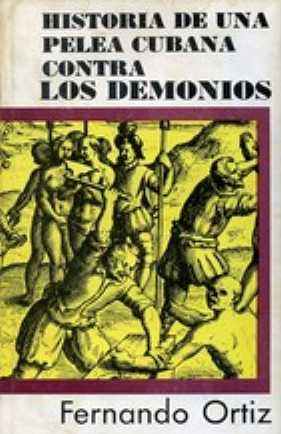4.4.2.11 “History of a Cuban Fight Against Demons,” by Fernando Ortiz (1881 – 1969)

“History of a Cuban Fight Against Demons,” symbolically published by Fernando Ortiz in 1959, had the eloquent subtitle that reads:
“A documented account and a folkloric and almost theological gloss on the terrible conflict that, at the end of the 17th century, was fought in the town of San Juan de los Remedios by a greedy inquisitor, a black slave, a bewitched king, and a large number of pirates, smugglers, merchants, cattle ranchers, mayors, captains, clerics, lunatics, and thousands of devils under the command of Lucifer.”
In this sense, the author intends to imitate the string of words that were used to title or subtitle many books from the medieval period and that survived into the colony, in his attempt to penetrate, through language and a profuse documentation that is not immediately guessed in reading, the colonial period of Cuba, around the 17th century and the economic, political, and ecclesiastical interests that gravitated over the Island.
The demonic is present in the breath of the chapters that make up the work, as a demonstration of the author’s erudition and his knowledge of the belief systems that intertwined Cuban society of yesteryear, as well as the interplay of the Inquisition and other elements that come together in a narrative close to the marvelous real.
The work reveals the social composition of that era and the deep class divisions, the roles played in relation to colonial domination, and also that of the Church, whose motives are revealed as more material than spiritual, and its connection with other mechanisms of domination, determining the colonial status quo.
This approach to colonial society is filtered through a certain irony, similar to Cuban humor, but which does not imply the abandonment of a scientific perspective and a higher cultural zeal, in no way evasive in the sense that has been pejoratively attributed to this very Creole type of humor.
The title may also refer to the circumstances prevailing at the time of its writing, with deliberate ambiguity, for although Ortiz had little involvement in political affairs, the evolution of his ideology, based on an eternal cultural matrix, allowed him to understand the need to undertake a new liberating feat with respect to the United States and to somehow transform the situation in the country.
Miguel Barnet quotes a phrase from the work and tacitly interprets it as meaning support for the Revolution:
“In “A Cuban Fight Against the Demons,” he had written these words with brilliant intuition, as the Batista gunpowder exploded on the island and the bearded ones rose up in the mountains: “The star of Cuba sparkles in another dawn with its bloody glow. It seems that the sun in the east of its shield is fully rising and will shine brightly.”
The book served as inspiration for the film also titled “A Cuban Fight Against the Demons”, produced at the Cuban Institute of Cinematographic Art and Industry (ICAIC), located at 23rd Street, # 1155, between 10th and 12th,
Vedado, Havana. The film, directed by Tomás Gutierrez Alea, who displayed all his creative talents, won the CIDALC Award at the Karlovy Vary International Film Festival in Czechoslovakia in 1972.








